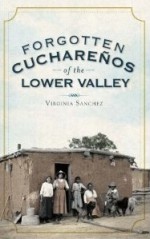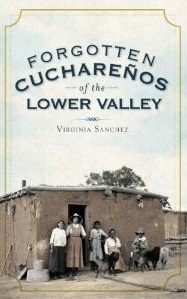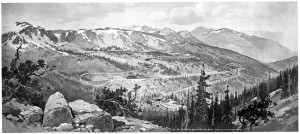Forgotten Cuchareños of the Lower Valley By Virginia Sanchez
The History Press, Paperback, 191 pp $19.99
ISBN #1609491343
Reviewed by Annie Dawid
As a fiction writer, reading Virginia Sanchez’s book about the history of Hispano Southern Colorado made me wish I were writing a long-planned, much-delayed novel which takes place in the Huérfano Valley during the 20th century. Forgotten Cuchareños of the Lower Valley is a researcher’s dream of a book: appendices, maps, bibliographies, indices, timelines, excellent photographs of now-disappeared buildings, monuments, cultural artifacts.
 Even if you are not writing a book which takes place in the Huérfano, this volume will delight any reader interested in the history of our area, especially that of the Hispano beginnings of this part of the world. The Cucharas and Cucharas City Sanchez chronicles bear no relation to today’s contemporary town of Cuchara near La Veta. Instead, these towns no longer exist, though they were once populated by numerous Hispano settlers, Ute tribal members and various Anglos, whose collective history Sanchez, a writer who has traced her ancestors back to the Spanish Province of New Mexico in 1598, imparts to her reader with grace and skill.
Even if you are not writing a book which takes place in the Huérfano, this volume will delight any reader interested in the history of our area, especially that of the Hispano beginnings of this part of the world. The Cucharas and Cucharas City Sanchez chronicles bear no relation to today’s contemporary town of Cuchara near La Veta. Instead, these towns no longer exist, though they were once populated by numerous Hispano settlers, Ute tribal members and various Anglos, whose collective history Sanchez, a writer who has traced her ancestors back to the Spanish Province of New Mexico in 1598, imparts to her reader with grace and skill.
The major focus of this volume, Cucharas and its inhabitants, was a town settled in 1866 northeast of Walsenburg. Many were sheep ranchers and farmers of Hispano descent, who appeared to live in general peace with their Native American neighbors until the arrival of Anglos, who pushed for more commerce and the ranching of cows over sheep, whose damage to the land rendered continued sheep ranching nearly impossible. “Like their Native American neighbors, (the Cuchareños) lived off the land. Their clothing came from animal skins and woven materials. Their food source came from seed and sheep.”
The first longhorn cattle from Texas arrived in 1870. “Trouble occurred when a sheepherder encountered Anglo cowboys herding cattle. Flocks herded by Hispanos and Native Americans were attacked and the sheep mutilated, poisoned or clubbed to death by cowboys.” After having to hire new herders several times, sheep rancher Juan Vallejos jumped out from behind some bushes of soapweed “with his 30-30 blazing.” He prevented the cowboys from injuring his sheepherder, made them dismount, remove their boots, and had them walk home barefoot over cactus and twigs. “That was the last whippin’ by them Lewises.”
The arrival of the railroad would change everything, as it did everywhere in the industrialized world of the 19th century. When the Denver & Rio Grande Railroad (D&RG) arrived in Cucharas in 1876, it became a hub for the transport of wool, sending Huérfano products as far as Boston, although the trade was controlled primarily by Anglos. These Anglos moved to a cash- and credit-driven economy, which resulted in further disenfranchisement of the Native population.
“By 1866, the southern Ute Indians were reassigned to the Indian Agency in Cimarron, New Mexico Territory, more than 125 miles away. The Utes went hungry and were near naked because the agency was undersupplied. Because Indians were forbidden to hunt, they could not obtain animal hides for clothing and wild game for food.” The starving and mistreatment of the Utes prompted them to make raids north into the Trindidad area, which caused more federal crackdown on Natives, eventually resulting in a displacement of the tribe further West into Utah.
Sanchez also writes about the habit of “captive-taking” by both Native and Hispano groups, resulting in various mixed families of multiple generations. Just after the Civil War, the U.S. government, seeking to enforce the newly enacted Civil Rights act banning slavery, began to interfere in this practice, wherein “owners” worked and clothed and housed their captives in their new environments. Not surprisingly, male Hispano “owners” sometimes ended up procreating with and marrying their female Navajo captives, resulting in the inheritance of land by children of mixed descent.
We learn about the practice of Catholicism by this population, which included the Penitente rites of Holy Week. “Many Anglos criticized the Penitente rituals and exaggerated about them in newspapers and books.” Later, the Ku Klux Klan in the 1920s would burn crosses and otherwise intimidate Catholics in the area, leading to the eventual demise of the Penitente practice.
Although the narrative of the book ends with the chapter “The End of Cucharas,” more pages follow in which the reader can chart this history with reproductions of primary documents and fascinating photographs of a world no longer extant.



